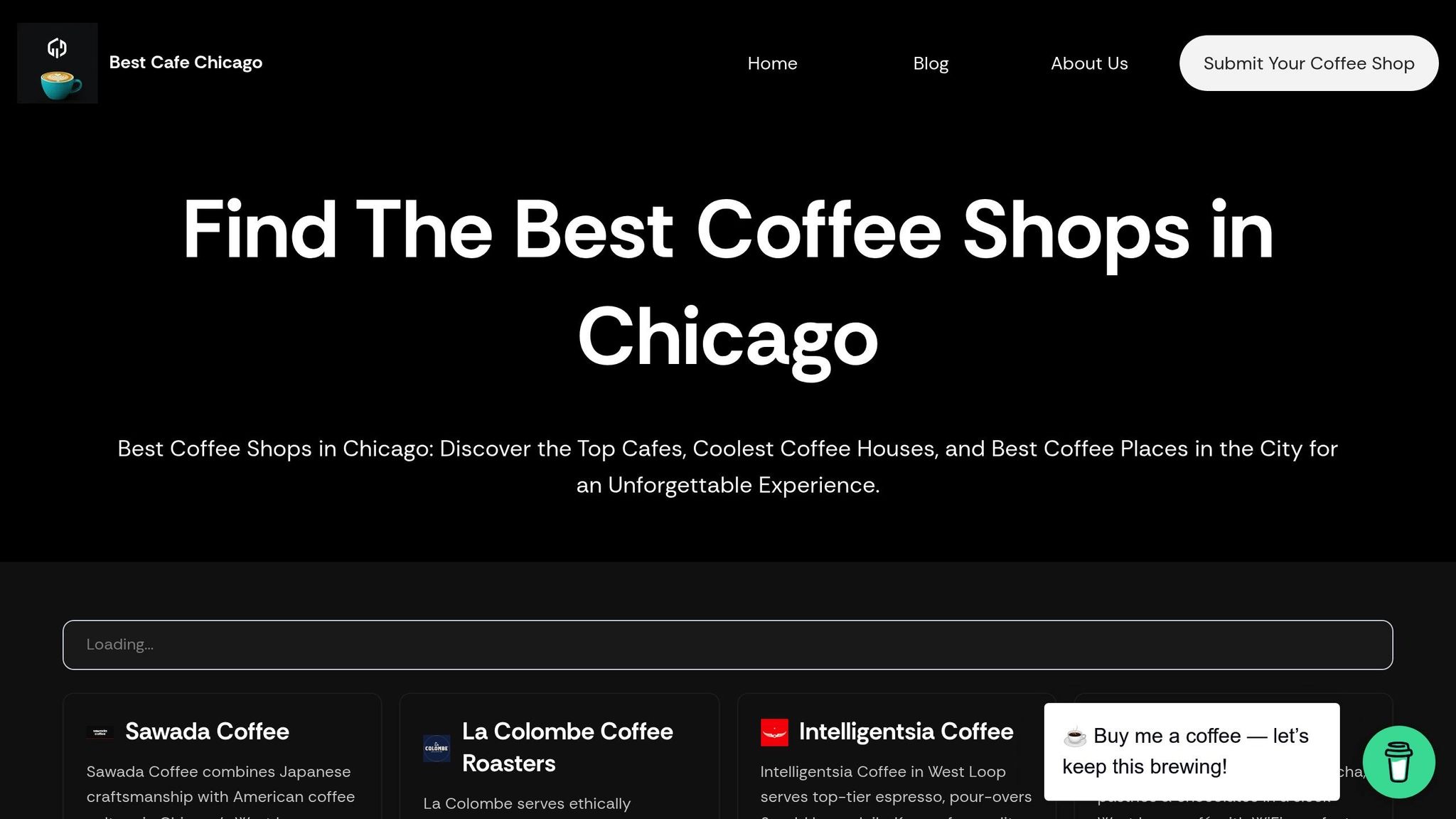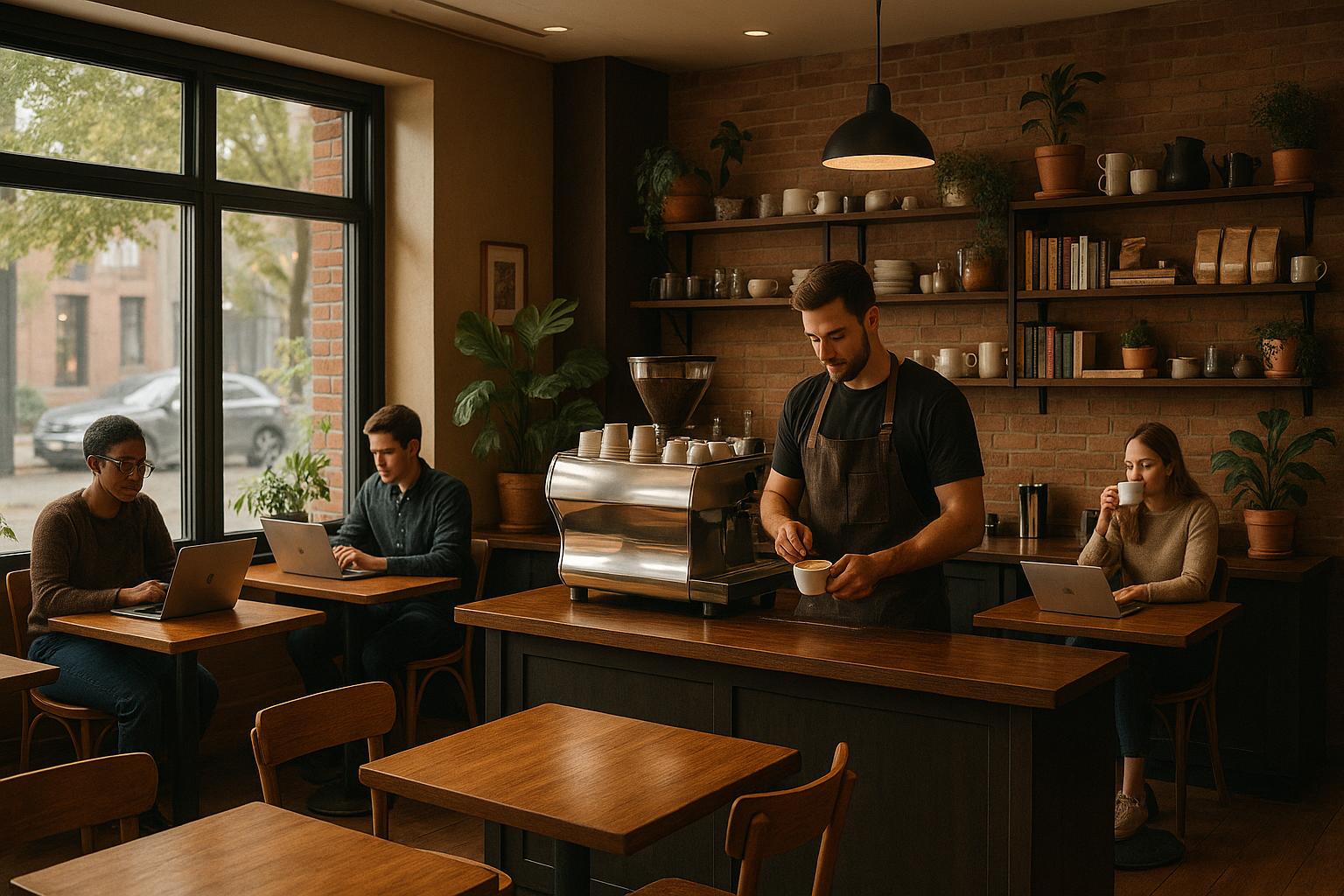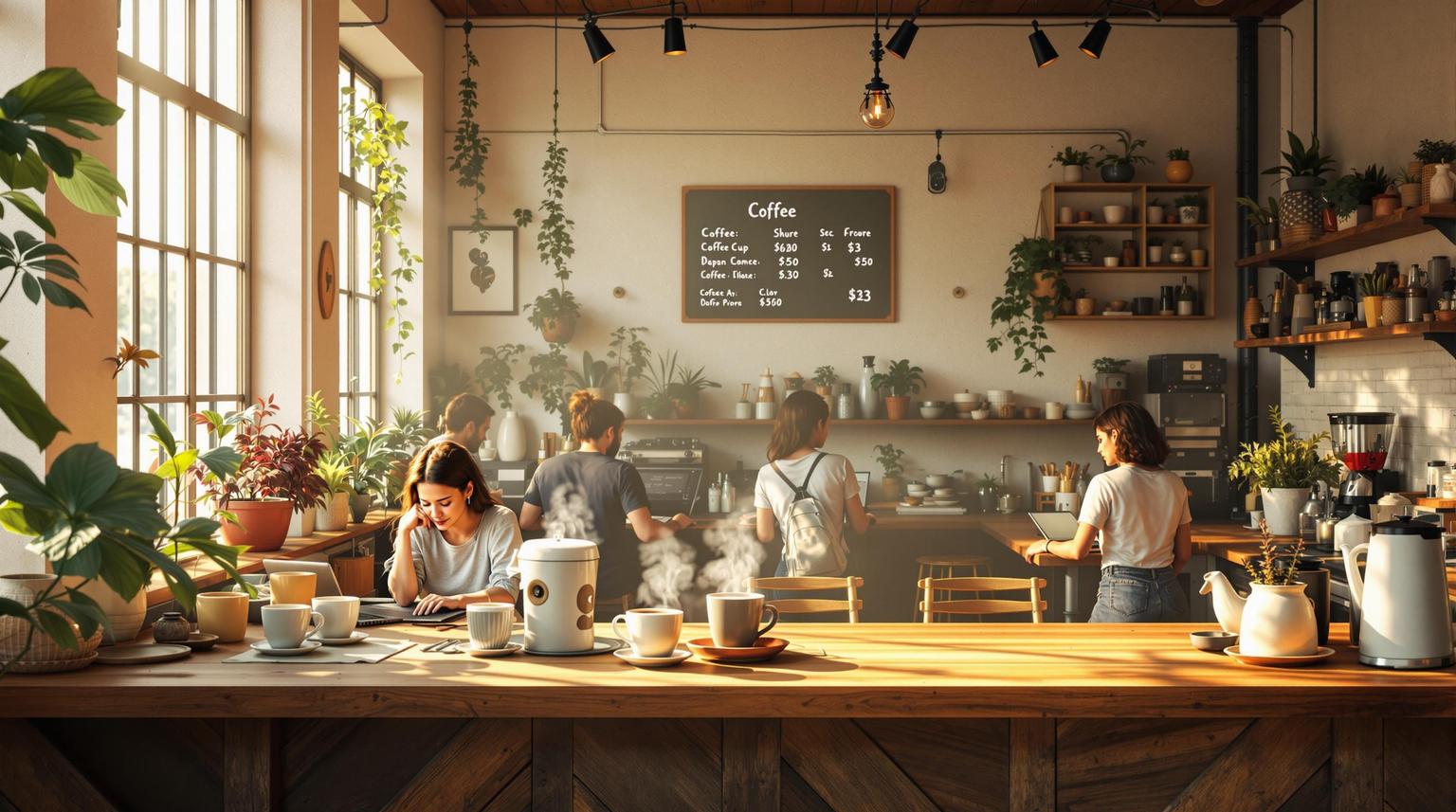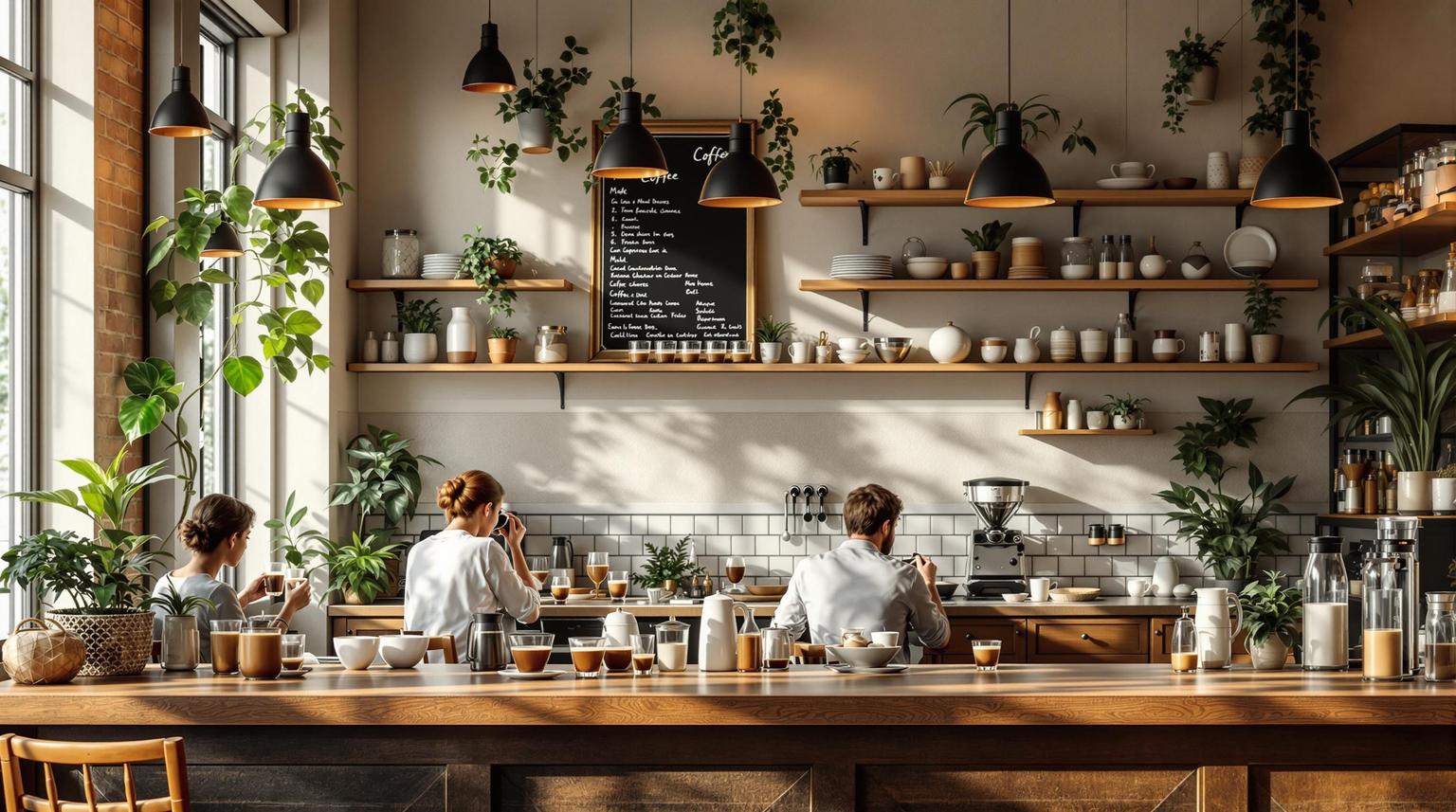Counter design in coffee shops directly affects how efficiently baristas work and how smoothly customers are served. A well-organized counter reduces unnecessary movements, speeds up service, and minimizes strain on staff, while poor layouts can lead to delays, frustration, and even safety risks. Here’s a quick breakdown:
- Customer Flow: Intuitive layouts guide customers from ordering to pickup without confusion or crowding.
- Equipment Placement: Tools like espresso machines, grinders, and milk frothers should be grouped to minimize movement.
- Task Zones: Separate areas for coffee prep, cold drinks, and food service prevent interference and boost productivity.
- Café Size Matters: Small cafés benefit from compact, linear layouts, while larger spaces thrive with U-shaped or island designs.
- Chicago-Specific Insights: Seasonal demands and limited space in neighborhood cafés require tailored solutions, such as dedicated cold drink stations or raised pickup zones.
Effective counter design balances functionality for baristas and comfort for customers, ensuring faster service and a better experience. Let’s dive deeper into how these principles apply to different café setups.
How To Design An Efficient Coffee Bar Workflow: Lessons from World Barista Championships
Core Principles of Good Counter Design
Efficient café counter design is all about creating an environment where baristas can work seamlessly, and customers can enjoy quick, hassle-free service. By focusing on three key principles, you can significantly improve both staff performance and customer satisfaction.
Simple Order Flow
The path customers take through your café - from entering to ordering to picking up their drinks - should be intuitive. A straightforward, one-way flow reduces confusion and prevents bottlenecks. Ideally, customers should enter near the ordering counter and exit near the pickup area. This setup minimizes crowding and allows staff to focus on crafting drinks rather than managing foot traffic.
Brice Young, owner of Precision Pours, advises café owners to carefully map out the flow of customers, food, and beverages to identify and eliminate bottlenecks. According to him, this approach not only speeds up service but also encourages repeat visits[2].
Clear visual cues, like open sight lines between the ordering counter and preparation areas, can further enhance the experience. They help customers understand the process while improving communication between staff and patrons.
Now, let’s explore how the strategic placement of equipment plays a role in maintaining this efficient flow.
Smart Equipment Placement
Where you position your espresso machine, grinder, and milk frother can make or break your baristas' workflow. Grouping related equipment together ensures that baristas can move smoothly between tasks like grinding beans, pulling espresso shots, and steaming milk. For instance, placing the grinder next to the espresso machine and keeping the milk steamer within arm's reach can make drink preparation significantly faster.
Pay special attention to the milk steaming station, a common pain point in café workflows. Position it so that baristas can monitor espresso extraction while steaming milk, and make sure there’s enough counter space nearby to stage multiple drinks at once[2]. Additionally, keep frequently used supplies and ingredients within easy reach to save time and effort[4].
Clear Zones for Different Tasks
Once you’ve optimized flow and equipment placement, the next step is to establish distinct zones for specific tasks. Dedicated zones reduce interference, helping staff work more efficiently. For example, a coffee preparation zone should include the espresso machine, grinder, and related tools. This setup allows baristas to focus on making coffee without distractions while maintaining a clear view of customers.
Similarly, a separate area for cold drink assembly - complete with blenders, cold brew taps, and refrigerated ingredients - ensures that iced drinks and smoothies don’t disrupt espresso-based orders. Food service areas should also be distinct, with equipment like warming ovens and prep surfaces kept apart from coffee-making zones. This separation not only boosts efficiency but also helps maintain food safety standards[1][3].
| Zone Type | Key Equipment | Function |
|---|---|---|
| Coffee Preparation | Espresso machine, grinder, milk steamer | Hot coffee drinks, espresso-based beverages |
| Cold Drink Assembly | Blenders, cold brew taps, refrigerated storage | Iced drinks, smoothies, cold brew |
| Food Service | Warming ovens, display cases, prep surfaces | Pastries, sandwiches, light food items |
Counter Layouts for Different Café Sizes
The size of your café plays a huge role in determining the best counter layout. What works perfectly in a cozy, intimate space could create chaos in a bustling, high-traffic establishment. Tailoring your workspace to match your café’s specific needs - both in terms of size and customer volume - is key to keeping operations running smoothly. Let’s dive into how small and large café layouts meet different demands.
Small Café Layouts
In smaller cafés, every square foot matters. Compact linear designs, like straight-line or L-shaped counters, are often the go-to choice. These layouts allow a single barista to handle tasks efficiently without wasting time or energy on unnecessary movement.
To make the most of a small space, vertical storage is a lifesaver. Wall-mounted shelves can hold supplies without eating up counter space, while multi-functional equipment - like an espresso machine with a built-in grinder or a refrigerated display case that doubles as a prep area - helps you do more with less.
For example, many cafés in Chicago adopt these principles to streamline their setups. By placing equipment strategically, they minimize the distance between key tasks like taking orders, making drinks, and handling payments. This reduces redundant movement and keeps service quick and efficient.
Even in a tight space, it’s important to balance functionality with customer comfort. A well-sized counter should provide enough room for drink prep while still allowing customers to approach easily. Small cafés thrive on compact efficiency, but larger spaces require layouts that support more complex operations.
Large Café Layouts
Larger cafés need layouts that can handle multiple baristas and higher customer volumes without bottlenecks. Island or U-shaped counters are common in these spaces, as they create distinct zones for different tasks while keeping the team connected both visually and physically. For example, one section might handle cold drinks and order-taking, while another zone focuses on espresso-based beverages - all anchored by a central prep area for shared supplies.
To keep things running smoothly, it’s helpful to designate specific areas for completed orders. A raised pickup station, separate from active prep zones, can prevent confusion and speed up service. Placing high-use equipment like drip coffee makers or cold brew taps near the register also helps streamline the process, while quieter corners can house specialized tools for more intricate drink preparations.
This kind of thoughtful zoning ensures that even during a rush, the workflow remains organized and efficient.
Layout Comparison
Here’s a quick side-by-side look at how small and large café layouts differ:
| Aspect | Small Café Layout | Large Café Layout |
|---|---|---|
| Counter Configuration | Compact linear or L-shaped designs | Spacious island or U-shaped designs |
| Barista Stations | Single, multi-tasking station | Multiple stations for team coordination |
| Equipment Strategy | Multi-functional, space-saving units | Specialized, high-capacity equipment |
| Storage Approach | Vertical wall-mounted solutions | Floor cabinets and extended counter space |
| Customer Flow | Streamlined, single-path ordering and pickup | Separate zones for ordering, prep, and pickup |
| Throughput Capacity | Handles moderate customer volumes | Built for high customer volumes |
| Space Efficiency | Maximizes limited space | Focuses on workflow over space-saving |
The right counter layout can make or break your café’s efficiency. Whether you’re working with a cozy nook or a sprawling space, aligning your design with your café’s size and customer flow ensures smooth operations and happy customers. A mismatched layout, on the other hand, risks creating unnecessary challenges during busy times.
sbb-itb-1371159
Common Workflow Problems and How to Fix Them
Even with a thoughtfully designed counter, workflow challenges can creep in as customer traffic grows. Identifying these issues early and applying targeted fixes can turn a chaotic workspace into a well-oiled machine.
Identifying Workflow Problems
Workflow hiccups often arise from poor equipment placement or insufficient space planning. Here are some common trouble spots:
- Crowded pickup areas: When completed drinks pile up near the register, customers cluster around the counter, blocking barista movement and slowing service.
- Cross-traffic issues: If food prep and beverage-making zones overlap, baristas are forced to navigate around each other, wasting time and increasing frustrations.
- Inaccessible storage: Supplies stored far from where they’re needed - like cups not near the espresso machine - add unnecessary steps to routine tasks. Similarly, hard-to-reach cleaning supplies disrupt efforts to maintain a tidy workspace.
- Limited sight lines: When baristas can't easily see teammates or the order queue, they might duplicate efforts or miss orders altogether.
Practical Solutions for Better Workflow
Tackling these issues requires strategic adjustments. Here are some actionable fixes:
- Reposition equipment: Keep essential tools and supplies within arm’s reach. For example, placing milk steamers closer to espresso machines can save steps and allow baristas to multitask more efficiently.
- Designate handoff zones: Create a clear, separate area for completed orders. A raised platform or a distinct section of the counter can guide customers to pick up their drinks without crowding active workspaces.
- Organize storage smartly: Store items where they’re used - cups by the espresso machine, lids near the pickup area, and cleaning supplies in easily accessible spots.
- Separate work zones: Assign specific areas for hot drinks, cold beverages, and food prep to minimize overlap and interruptions.
- Add visual cues: Use labeled shelves, color-coded storage containers, or even floor markings to guide both new and experienced staff in maintaining smooth workflows.
These adjustments not only streamline operations but also improve communication among team members.
Improving Barista Communication
Clear communication is a cornerstone of efficient workflows. Here’s how to make it happen:
- Maintain sight lines: Ensure baristas can see each other and the order queue by removing obstacles like oversized equipment or tall storage units. This visual connection helps team members anticipate needs and avoid confusion.
- Establish protocols: Simple practices - like calling out drink names during preparation, confirming special requests, and announcing low supplies - keep everyone on the same page, especially during busy periods.
- Consider acoustics: Reduce noise by minimizing echoes from hard surfaces and placing loud equipment away from key areas. This ensures baristas can hear each other clearly, even during peak hours.
The secret to solving workflow challenges lies in regular observation. What works during a slower afternoon might not be effective during the morning rush. By continually assessing and tweaking your setup, you can keep your workspace running smoothly as your business grows and evolves.
Chicago Coffee Shop Considerations
Chicago's coffee scene brings unique challenges that directly influence counter design. With its harsh winters, diverse neighborhoods, and thriving coffee culture, café owners must carefully plan their spaces to meet local demands while staying functional and inviting.
Working with Chicago's Coffee Culture
Seasonal changes in Chicago create distinct demands for coffee shop layouts. During the frigid winters, when temperatures plummet, people tend to linger indoors, leading to increased peak demand for hot beverages. Counter layouts need to handle this surge efficiently, ensuring smooth service during busy times.
At the same time, the rising popularity of cold brews has led many cafés to dedicate specific areas for cold beverage preparation. By separating cold and hot stations, cafés can maintain optimal temperatures and keep service flowing smoothly.
Chicago's coffee shops also cater to a growing number of freelancers and remote workers who use these spaces as work hubs. This trend calls for flexible seating arrangements that accommodate both quick visits and extended stays, blending functionality with comfort.
In smaller neighborhood cafés, space is often limited. To make the most of these tighter areas, counters should be thoughtfully organized into distinct zones for ordering, preparation, and pickup. This kind of layout maximizes efficiency and ensures a seamless workflow, even in compact spaces.
Examples of Efficient Local Cafés
Some local coffee shops have already nailed these design strategies. BestCafeChicago.org highlights standout examples of cafés that have tailored their counter setups to meet Chicago's unique demands. These businesses have found ways to enhance both barista productivity and customer experience.
For instance, many of these cafés use raised pickup zones or dedicated counter sections to streamline customer flow and speed up transitions. This approach not only keeps things moving efficiently but also creates a more enjoyable experience for customers.
The directory also showcases how some cafés balance quick service with longer stays. By separating fast-service areas from relaxed seating zones, they ensure that customers with different needs can coexist without disrupting the overall vibe.
Cold brew-focused cafés have taken things a step further by incorporating specialized equipment and dedicated counter sections. These setups not only maintain the quality of cold beverages but also help baristas serve customers more quickly and effectively.
Designing for U.S. Standards
In addition to catering to local preferences, counter designs in Chicago must adhere to U.S. technical standards. For example, compliance with ADA (Americans with Disabilities Act) regulations often requires counters to include lowered or multi-level sections to ensure accessibility for all customers.
Since construction in the U.S. relies on imperial measurements, designers must carefully plan counter dimensions and equipment spacing to align with these standards. Electrical and plumbing codes also come into play, requiring proper placement of outlets, water lines, and equipment to meet local regulations.
Temperature management is another critical factor. Equipment must be positioned with adequate ventilation to maintain performance, especially during the city's warmer months. Health department regulations further influence design choices, dictating the use of approved materials and surface finishes to ensure sanitation and support efficient workflows.
Conclusion: Designing for Efficiency and Customer Satisfaction
The design of a coffee shop counter is more than just aesthetics - it's the linchpin of smooth operations. The way a counter is laid out directly influences how efficiently baristas work, how quickly customers are served, and ultimately, the shop's profitability.
Key Takeaways
Here’s a quick recap of the core principles:
- Streamlined order flow is essential. When customers can seamlessly move from placing their order to picking it up without confusion or congestion, everyone wins. This applies whether it's a cozy neighborhood café or a bustling, multi-station coffee shop.
- Strategic equipment placement is critical. Positioning tools and machines in a way that supports workflow efficiency not only saves time but also helps adapt to varying customer demands, like Chicago's seasonal coffee trends.
- Adherence to U.S. standards ensures accessibility and compliance. Features like ADA-compliant counter heights, proper equipment ventilation, and meeting health department regulations make the space more inclusive and functional for all.
The best counter designs strike a balance between operational efficiency and creating a welcoming environment that keeps customers coming back.
Explore BestCafeChicago.org

Want to see these ideas in action? BestCafeChicago.org is a directory that showcases some of Chicago's standout coffee shops, many of which embody these counter design principles. From small, perfectly optimized cafés to larger spaces that handle high customer volumes, the site highlights real examples of effective layouts and workflows.
Browse their listings to discover coffee shops excelling in areas like cold brew preparation, cozy atmospheres, and work-friendly setups. Each example underscores how thoughtful counter design can prioritize both barista efficiency and customer satisfaction.
Whether you're opening a new café or revamping an existing one, these real-world examples offer inspiration for creating a space that works for everyone.
FAQs
How does a café’s size affect its counter design and barista workflow?
The size of a café significantly influences the choice of counter design and how efficiently baristas can operate. For smaller cafés, compact layouts like linear or back-to-back counters are ideal. These designs save precious space and cut down on unnecessary movements, helping baristas stay organized and work effectively within tight quarters.
On the other hand, larger cafés can embrace more spacious layouts with clearly defined zones for tasks such as drink preparation, taking orders, and cleaning. This segmented approach not only streamlines operations but also improves customer flow and allows multiple baristas to work side by side without stepping on each other’s toes. Selecting the right layout is key to creating a functional workspace while ensuring a smooth customer experience, regardless of the café's size.
How can coffee shops improve barista workflow through better counter design?
Improving a barista's workflow starts with smart counter design. Well-planned layouts can cut down on unnecessary movement by ensuring tools and ingredients are always within arm’s reach. For instance, arranging espresso machines, grinders, and milk frothers in a triangular setup can make drink preparation quicker and more efficient.
Another important factor is flexibility. Adjustable counters or modular stations allow the workspace to adapt to high-demand periods, keeping things efficient even during the busiest times. On top of that, clear signage for both staff and customers, paired with tools like modern POS systems, can reduce confusion and keep everything running smoothly.
Focusing on practical design and functionality not only boosts productivity but also makes the environment more enjoyable for everyone involved - baristas and customers alike.
How can coffee shop owners design counters that meet U.S. regulations?
To ensure their counters meet U.S. regulations, coffee shop owners should start by consulting local health department guidelines. These often require submitting design plans for approval and adhering to food safety rules, such as installing sneeze guards to prevent contamination. Counters must also align with commercial kitchen standards, which typically call for non-porous, easy-to-clean materials, proper counter heights (usually capped at 34 inches), and enough space to maintain an efficient workflow and proper sanitation.
On top of that, it's crucial to comply with the Americans with Disabilities Act (ADA) to make the space accessible to all customers. Following these guidelines helps coffee shop owners create an environment that’s not only safe and functional but also welcoming to everyone while staying within the boundaries of U.S. laws.


